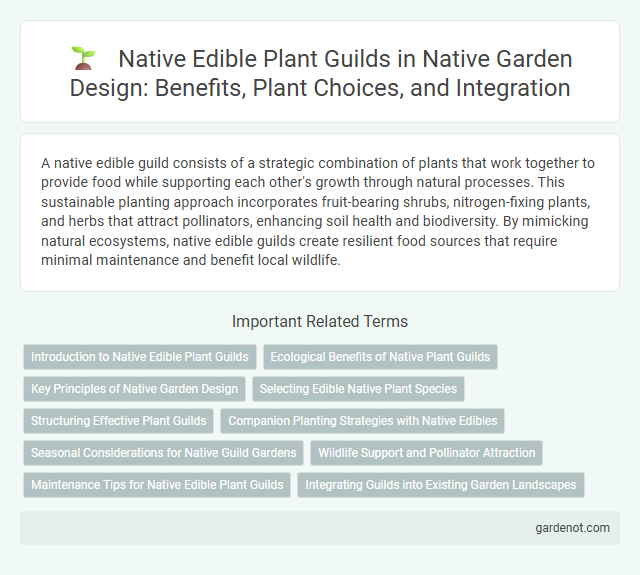A native edible guild consists of a strategic combination of plants that work together to provide food while supporting each other's growth through natural processes. This sustainable planting approach incorporates fruit-bearing shrubs, nitrogen-fixing plants, and herbs that attract pollinators, enhancing soil health and biodiversity. By mimicking natural ecosystems, native edible guilds create resilient food sources that require minimal maintenance and benefit local wildlife.
Introduction to Native Edible Plant Guilds
Native edible plant guilds combine complementary species that support biodiversity, improve soil health, and provide sustainable food sources. These guilds typically include nitrogen-fixing plants, deep-rooted species, and nutrient accumulators, creating a self-sustaining ecosystem ideal for native food cultivation. Understanding the interactions within these guilds enhances resilience and productivity in native planting landscapes.
Ecological Benefits of Native Plant Guilds
Native edible plant guilds enhance soil health through natural nutrient cycling and nitrogen fixation, supporting diverse microbial communities. These guilds create habitats for pollinators and beneficial insects, increasing local biodiversity and ecosystem resilience. By minimizing the need for chemical inputs, native plant guilds contribute to sustainable land management and water conservation.
Key Principles of Native Garden Design
Native edible guilds emphasize plant diversity by integrating fruit trees, nitrogen-fixing shrubs, and herbaceous plants to create a self-sustaining ecosystem. This design leverages natural symbiotic relationships to improve soil health, enhance pest resistance, and optimize nutrient cycling. Strategic layering of canopy, understory, and ground cover plants maximizes space and sunlight utilization while supporting native pollinators.
Selecting Edible Native Plant Species
Selecting edible native plant species involves prioritizing plants that are well-adapted to local climate and soil conditions, ensuring sustainable growth and resilience. Key species often include wild berries like serviceberry (Amelanchier spp.), groundnuts (Apios americana), and pawpaw (Asimina triloba), which provide nutritious yields and support biodiversity. Incorporating diverse native perennials enhances ecosystem stability while offering reliable, culturally significant food sources for native edible guilds.
Structuring Effective Plant Guilds
Structuring effective native edible plant guilds involves selecting complementary species that promote biodiversity, soil health, and sustainable food production. Key components include nitrogen-fixing plants like clover or lupine, dynamic accumulators such as comfrey, and fruit-bearing natives like serviceberry or pawpaw, which support pollinators and enhance nutrient cycling. Proper layering and spacing optimize sunlight capture and water use, creating resilient ecosystems that yield diverse, nutritious crops.
Companion Planting Strategies with Native Edibles
Native edible guilds utilize companion planting strategies to enhance growth, pest resistance, and soil health by pairing compatible native species like squash, beans, and corn. These guilds mimic natural ecosystems, promoting biodiversity and sustainable harvests while reducing the need for chemical inputs. Strategic companion planting within native edible guilds supports nutrient cycling and attracts beneficial pollinators, ensuring resilient and productive gardens.
Seasonal Considerations for Native Guild Gardens
Seasonal considerations for native edible guild gardens optimize plant growth and harvest cycles by aligning with local climate patterns and native species' natural rhythms. Incorporating early spring bulbs, summer-bearing perennials, and late-season fruiting shrubs ensures continuous yield and supports ecosystem balance. Understanding frost dates, precipitation trends, and pollinator activity enhances productivity and resilience in native guild designs.
Wildlife Support and Pollinator Attraction
A native edible guild combines fruit-bearing plants, nitrogen-fixing species, and pollinator-attracting flowers, creating a resilient ecosystem that supports local wildlife. These plant communities provide essential food sources and habitats for pollinators like bees, butterflies, and hummingbirds, promoting biodiversity and enhancing pollination efficiency. Incorporating native edibles alongside flowering ground covers and shrubs ensures sustained nectar availability, boosting both wildlife support and crop yields.
Maintenance Tips for Native Edible Plant Guilds
Maintaining a native edible plant guild requires regular monitoring of soil moisture to ensure optimal hydration without waterlogging the roots. Pruning invasive species and controlling weeds helps preserve the balance between plants, promoting healthy growth and nutrient sharing. Mulching with organic materials supports soil health by retaining moisture and suppressing unwanted vegetation, facilitating sustainable, low-maintenance cultivation.
Integrating Guilds into Existing Garden Landscapes
Integrating native edible guilds into existing garden landscapes enhances biodiversity while maximizing space efficiency and ecosystem resilience. By combining complementary native plants such as nitrogen-fixing shrubs, deep-rooted trees, and ground-covering herbs, gardeners create self-sustaining plant communities that improve soil health and increase food production. This approach fosters pollinator habitats and natural pest control, promoting sustainable and productive garden ecosystems.
Native edible guild Infographic

 gardenot.com
gardenot.com